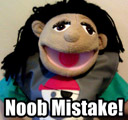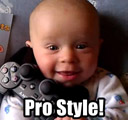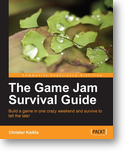This article by Christer Kaitila, author of The Game Jam Survival Guide focuses on the early stages of a Game Jam. These most important first few hours will set the state for the rest of your experience. Topics that we will cover include:
- Dealing with the Game Jam theme
- An example of a winning entry
- Coming up with a plan of action
- Brainstorming and prototyping
The Game Jam Survival Guide
Build a game in one crazy weekend and survive to tell the tale! with this book and ebook Dealing with the Game Jam "theme" Virtually every Jam requires that you try to make a game that fits a theme. This is either a surprise word that the moderators came up with or one that has been voted upon earlier.
The theme for a Jam is typically announced immediately before it begins. The anticipation and surprise gives the start of the event extra excitement and serves as a means to inspire the participants in the same way that the "secret ingredient" is used in the TV show Iron Chef .
Once the theme word or words have been announced, digest it for a while. Some suggestions for coming up with a great game concepts based on the theme are as follows:
- Take a walk
- Listen to music
- Mull over ideas away from the computer
- Come back home and sketch your idea
- Visualize the game being played before touching the keyboard
- Talk about the theme over dinner with a friend
- Sleep on it and start in the morning
Use this theme word as the genesis for your creative spark. Let it inspire you to think outside your normal comfort zone. Don't get discouraged if you think the theme isn't something you like: any game concept can be easily manipulated to fit a theme. Add one subtle reference and whatever game you'd hoped to make is still a possibility.
Haiku Time:
Many ideas.
They all seem to fit the theme!
Must I choose just one?
Games that tend to win Game Jam competitions often make use of the theme word to find endless material for humor.
One very strange statistical anomaly is that in most Game Jams, these three themes always score well in the voting stages: evolution, kittens, and fishing. Time and time again they are "always a bridesmaid, never a bride" and tend to be in the top ten, rather than the chosen theme. In Ludum Dare, for example, the "evolution" theme has been in the top ten almost a dozen times over the last six or seven years. When will "the evolution of kitten fishing" finally be the theme of a Game Jam?
What the experts say: Chevy Ray Johnston
A great way to come up with an idea to fit the theme is to write down the first five things that come to mind, then toss 'em. Those are the ideas everybody else is already thinking of and/or making.
If I could give one piece of advice to newcomers, it would be to make a really simple game, and spend all your time polishing it like crazy! Really polished games are addictive, impressive, and always popular.
Visual polish of some sort always seems to give games a boost-up in votes in compos, and makes them more likely to be clicked on by judges (especially in short Jams, where 90% of the games have little to no graphics). But unless you just care about winning, don't sacrifice a fun or engaging and interesting game just to make it look pretty.
The best thing about Game Jams is the ridiculous shortcuts and solutions developers come up with to solve design problems in such a short time span.
I hope that in the future, Game Jams will see more people developing not just video games, but other types of games as well; and creative things in general. I'm talking about writing Jams, board Game Jams, card Game Jams, and tech Jams where people get together and try to solve technological problems with the same mindset and ambition. Jams are great.

Blog: Chevyray.com
Twitter: Twitter.com
Flashpunk : Flashpunk.net
Google+ : Plus.google.com
An example of a winning entry
Let's take an example theme and see what it might inspire you to create. Take "ESCAPE," the theme of Ludum Dare 21.

Try it out: Flee Buster by Chevy Ray Johnston.
Chevyray.com
Other notable entrants created puzzle games where you had to escape from a mansion, jail, dungeon, or reverse pinball where you were the ball trying to get past the bottom. The possibilities are endless.
The key qualities that the top ten entries all had were:
- Humor
- Simple gameplay
- Simple graphics
- Easy to pick up and play (simple controls)
Coming up with a plan Once you've been given the theme, you have your team (if any), your tools are at the ready and your game engine is ready to be put to use, the next step can be the hardest: starting. Coming up with a plan takes time, and that's the one commodity in short supply during a 48 hour Game Jam.
Don't waste too many hours brainstorming, drawing flowcharts or writing a proper design document. That said, it would be foolish to forge ahead without some sort of direction. Therefore, a powerful and often used approach is to create a "minimal" design specification. Not a true design document "bible" like an AAA game team would produce, but instead a one-pager.
Building a game by first creating concept art
One way to approach your design is to create a "fake" screenshot of what you would like the game to look like in an art program (or simple drawn by hand on paper). This technique works really well, since a picture is worth a thousand words.
- Imagine your game
- Draw it in Photoshop (or scan a paper sketch)
- Chop up the image to create sprites
- Use them in your program
If you can quickly sketch a fake thumbnail of your game in action, you are able to visualize your final product. In five or ten minutes, you should be able to sketch a dozen thumbnails of game concepts this way and choose the best from the bunch.
Using graph paper or board game pieces
Another commonly used design technique for time-limited endeavors is to build a prototype of your game on paper using board game pieces. Games such as strategy and puzzle games, or rogue-like dungeon crawlers and tactics titles work best with this method.
Using plastic game pieces and graph paper (or lines drawn on a piece of paper) you might come up with a play-by-play for your game, a simple rule set, or a concept of what your first map should look like.


Don't worry about making it beautiful!
One of the key factors common to all Game Jam winners is that the games themselves aren't particularly beautiful. At the heart of gameplay is the "feel" and players will forgive simplistic, blocky stick figures if the game feels fun. Don't waste too much time sketching or creating fake screenshots that are works of art.
Concentrate on the important parts of your game
Movement
Controls
A way to "die"
Triggering a "win" state
The "feel"
Less important aspects worth saving for later include sounds and graphics, large levels, high score databases, and anything else that might be considered nonessential to the base gameplay.
Once your game functions, once you can jump around, shoot or make plot decisions, once you have created the most basic of prototypes where there is some movement or animation - only then is it worthwhile making the game world big or beautiful.
Your gorgeously hand-painted backdrop that is a masterpiece of art but isn't fun to play (or isn't finished!) will not be popular, regardless of how lovely it looks.
Avoid the latest fad—go low-tech
You can win a Game Jam with pixelated retro graphics that only use four colors. The proof of this fact is perfectly illustrated by the winning game pictured above. Many better looking games placed significantly lower in the rankings for a reason: the "feel".
By the same token, you don't have to use the latest-and-greatest technology. You can make a game in 2D instead of 3D, without any physics or amazing real-time lighting shaders. In fact, some people make games as simple web pages or games that don't even require a computer (like board games and role playing games).
Hexagon Empire—a board game designed during a Game Jam
The Global Game Jam ( GGJ) , for example, encourages participants to look beyond videogames to any kind of game design. Board games, card games and pen-and-paper role playing games in the vein of Dungeons and Dragons have been created at this game Jam.
What the experts say: Dr. Mike Reddy
Did you know that even FPS game designs have been tested using paper-based prototypes? Almost all the iconic video games of the last 40 years were designed on paper first. Brenda Brathwaite, a world-renowned game designer, has even pushed the boundaries of games as art with board games such as Train. All the cool game designers are doing it. All it takes is paper, glue, scissors, and some pens.
What's cool about board games for the GGJ? Well, first off any bugs are people bugs. You can talk through the error, and that itself can solve the problem. Making games by playing them. No waiting to compile! No crashes or backups. No programming gurus necessary. Any room with tables and chairs will do. Bring along as many games as you are able to, it can provide something to spark off ideas, or at least something to do in the breaks. A first draft prototype can be ready to test in 15 minutes. The computer people will have only just booted their PCs by then.

AltDevBlogADay : Altdevblogaday.com
GGJ Website : Gamesoc.newport.ac.uk
Google+ : Plus.google.com
Summary This article explained the importance of not wasting time with grand designs. Don't stress about the possibilities while brainstorming your game's outline. Dive in head first and get started as quickly as you possibly can!



I do "noob mistake" atm. :D (I'll finish shitload of models and do the coding later) Well I guess I need to change tactics.